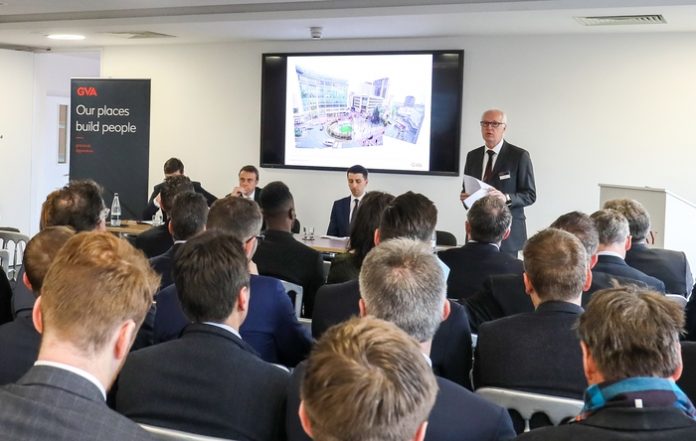
The Midlands office of GVA has launched its latest Evolving Cities map for Birmingham.
The updated map, which was last issued in 2016, outlines consented and in-progress office, residential, retail and leisure, and mixed-use schemes and provides a clear demonstration of how the city continues to expand outside of the traditional core, encouraging development and regeneration.
The event was hosted by GVA’s Ian Stringer, with Richard Cowell from Birmingham City Council’s Economy Directorate providing an overview of the city’s current development opportunities and context for growth.
Ian Stringer, GVA, said: “This latest version of the development pipeline map provides a clear demonstration of how the city council is driving growth and expansion of the city core out of the traditional bounds of the inner ring road in accordance with the Big City Plan.
“This is very much in line with the city’s ambitious growth agenda, which is itself a response to the anticipated upswing in population driven in part by rising regional employment growth. This is evident in the current wave of inward investment and northshoring activity, particularly through relocation precipitated by affordability constraints within the south east, which will support a strong future economy.
“Population growth and net migration, along with connectivity and infrastructure investment, and post-graduate retention from our top-rated regional universities are also anticipated to have a key role to play in the ongoing story of Birmingham’s growth.”
Alongside the launch of the map, Charles Toogood and Mark Birks – from GVA’s offices and residential teams respectively – presented on the current drivers and future pipeline trends to support the city’s markets.
The data provides a clear picture of how closely the office and residential sectors are aligned and the impacts that they have on one another.
The offices sector has seen both a rise in occupier demand and inward investment activity, with a particular focus on co-working space. Furthermore there has been a positive movement in rental values, constriction of supply and a fall in tenant incentives, all of which are emblematic of a highly in-demand market.
Charles Toogood, GVA, said: “While there is currently some 5 million sq ft of Grade A office space consented or under construction in Birmingham at schemes such as Three Snowhill, 103 Colmore Row and Paradise, active and anticipated requirements are likely to absorb a significant amount of this stock on delivery
“As agile working trends become progressively pervasive across the Midlands commercial office market, we are likely to see falling densities and increasingly efficient floorplates. Ongoing interest in flexible, co-working and serviced office solutions will continue to fulfil some of the requirement for smaller, fleet-of-foot occupiers.”
While the city is seeing activity across all four of its main residential development zones – Eastside, Westside, Digbeth and the Jewellery Quarter – rising demand and growing sale and rental prices, coupled with the shrinking of traditional residential areas, are likely to have a positive knock-on effect on future viability.
This is forcing developers to consider alternative locations and housing solutions if Birmingham is to ensure that it has sufficient residential stock in place to meet the anticipated 51,000 units required by 2031.
Mark Birks, GVA, said: “For the first time in a decade, the city’s Westside has overtaken the Jewellery Quarter in terms of delivery of residential units. This has been boosted considerably by The Bank, a high-rise scheme of over 400 units which is on the doorstep of Brindleyplace and will play a significant role in realigning perceptions of residential zones within Birmingham.
“Future housing supply will be focused in key locations linked to the provision of new strategic infrastructure, such as HS2 and the planned extension to the Midland Metro tram. Ultimately however, factors such as build cost pressures and the viability gap will play an important role in shaping the location and delivery of this badly needed new housing.”




















